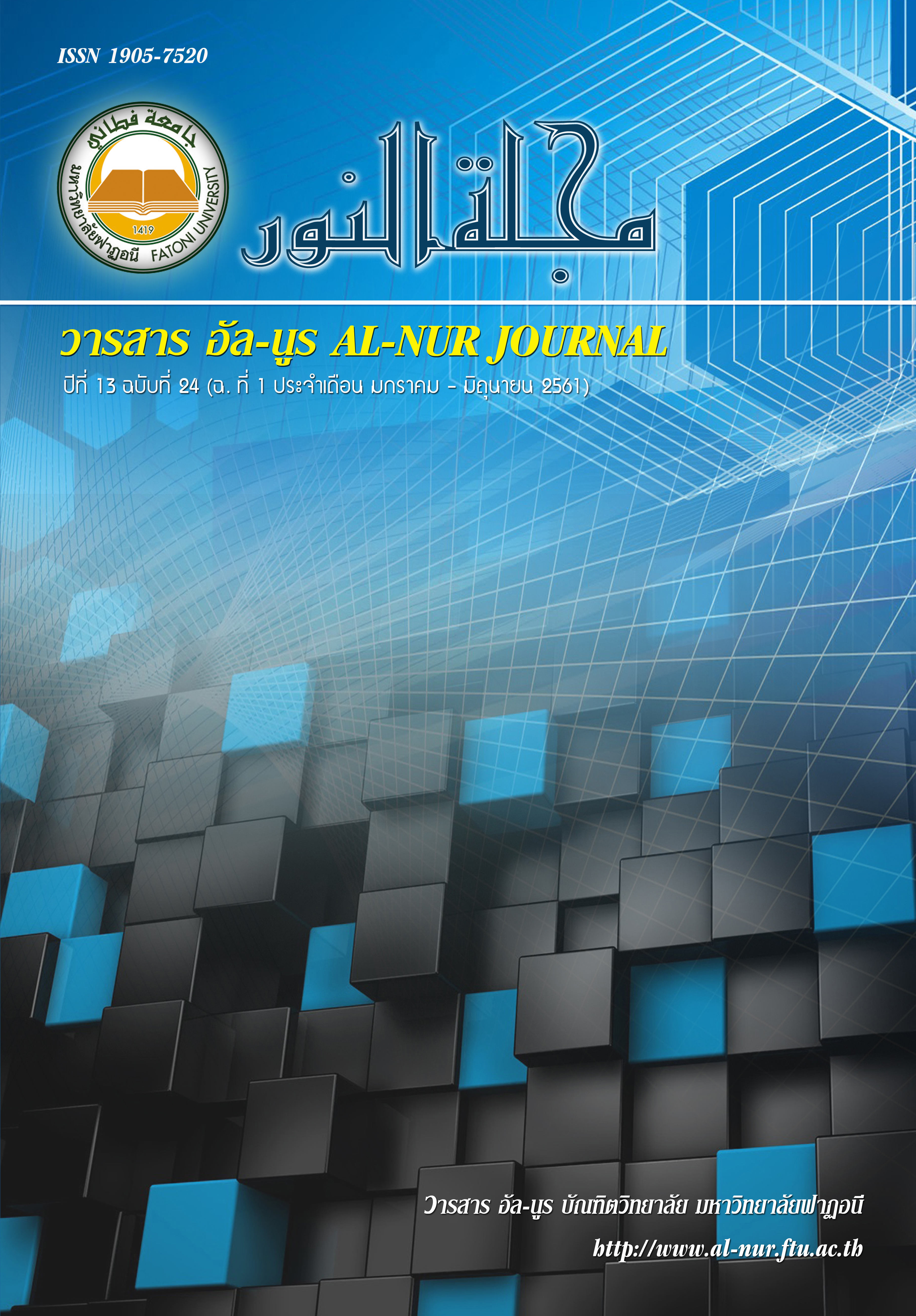Effect of Self-Management Program in Breathing Exercise and Al-Quran Listening on Blood Pressure in Muslims with Uncontrolled Hypertension
Keywords:
Self-management, Breathing exercise, Al-Quran listening, HypertensionAbstract
This research and Development (R&D) study. Applying the concept self-management theory of Kanfer and Gaelick-Buys (1991). Integrate the Al-Quran with breathing exercise. Using the Iowa development process, adapted by Titler et al (Titler, Kleiber, Steelman, Rakel, Budreau, & Everett, 2001). The study was divided into 2 phases, namely 1) the program development included understanding the problem, review of related research evidences and organizing the program integrates faith in the Al-Quran, and 2) program evaluation and feasibility of implementing the program. Program evaluation by 3 experts and program evaluation and feasibility of implementing the program by professional nurses for chronic non-communicable disease clinics of primary care 5 persons.
Self-management program in breathing exercise and Al-Quran listening on blood pressure in Muslims with uncontrolled hypertension comprised 4 parts: 1) guidelines for users program; 2) action plan for users program included 5 sub-activities, 4 activities; 3) Manuals and recordings program; 4) media, including reading and copying of Al-Quran, Yaseen. The program validation revealed 1) content was accurate, appropriate, clear and according with the objectives of the program. 2) Suggestions adding details of the environmental 3) Improve the record is more clear. Program evaluation and feasibility of implementing the program and all nurses 1) program were revealed content, satisfied with using program. 2) Manuals and recordings for self-management program were academically appropriate. 3) Interesting pictures and appropriate language were used. 4) It is recommended to add reading of Al-Quran, Yaseen in Manuals and recordings.
References
Bhavanani, A. B., Sanjay, Z., and Madanmohan. (2011). Immediate Effect of Sukha Pranayama on Cardiovascular Variables in Patients of Hypertension. International Journal of Yoga Therapy, 21.
Bhavanani, A. B., Madanmohan., and Sanjay, Z. (2012). Immediate effect of chandranadi pranayama (left unilateral forced nostril breathing) on cardiovascular parameters in hypertensive patients. International Journal of Yoga Therapy, 5, 108-111.
Bhavanani, A. B., Madanmohan, Sanjay, Z., and L Vithiyalakshmi. (2012). Immediate cardiovascular effects of pranava relaxation in patients with hypertension and diabetes. Biomedical Human
Kinetics, 4, 66-69.
Chaiyakul, C.(2557).Effects of self-management and family particpation enhancing program on health behavior and blood pressure among elderly with hypertension. Thesis Master of Science in Epidemiology faculty of Nursing Prince of Songkla University, Songkhla
Howorka, K., Pumprla, J., Tamm, J., Schabmann, A., Klomfar, S,. Kostineak, E., Howorka, N., and Sovova, E. (2013). Effects of guided breathing on blood pressure and heart rate variability in hypertensive diabetic patients. Autonomic Neuroscience : Basic & Clinical, 179, 131-137.
Jaipakdee, j. (2556). Effects of Deep Breathing and Muscle Relaxation on Blood Pressure and Stress in Hypertensive Patients. Thesis Master of Science in Epidemiology Facultyof Medicine. Siriraj Hospital Mahidol University, Bangkok
Jones, C, U., Sangthong, B., and Pachirat, O. (2010). An inspiratory load enhances the antihypertensive effects of home-baseed traning with slow deep breathing. Journal of physiotherapy, 56, 179-186.
Joseph, C, N., Porta, C., Casucci, G., Casirahi, N., Maffeis, M., Rossi, M., and Bernardi, L. (2005). Slow Breathing Improves Arterial Baroreflex Sensitivity and Decrease Blood Pressure in Essential Hypertension. Journal of American Heart Association, 46, 714-718.
Kanfer, F. H., & Gaelick-Buys, L. (1991). Self-management Methods. In F. Kanfer & A. Goldtein (Eds), Helping people chang: A text book of methods (4th Ed., pp. 305-360).
Kartiwati, A., Norwati, D., Juwita, S., and Mujahid, B. (2014). The Effect of Listening to Al-Quran Among uncontrolled Hypertension Attending Primary Care Clinic. Retrieved September 13, 2014, from http://www.researchgate.net/profile/Juwita_Shaaban/publication/264006197
Kaushik, R. M., Kaushik, R, Mahajan, S. K and Vemreddi, R. (2006). Effects of mental relaxation and slow breathing in essential hypertension. Complement Therapies in Medicine, 14, 120-126.
Khan, N., Ahmad, N, b., Alla, A, N, A., and Nubli, M. (2010). Mental and Spiritual Relaxation by Recitation of the Holy Quran. Paper presented at th 2nd International conference on computer
Research and Development, Pahang, Malasia.
Kosol, S. (2559). Development of a Family Empowerment Program for Pulmonary Rehabilitation. Elderly Chronic Obstructive Pulmonary Disease. Minor Thesis Master of Science in Epidemiology faculty of Nursing Prince of Songkla University, Songkhla
Oneda, B., Ortega, K, C., Gusmao, J, L., Araujo, T,G., and Jr, M, D. (2010). Sympathetic nerve activity is
decreased during device-guided slow breathing. Hypertension research, 33, 708-712.
Prasatguew, N., Teratongkum, S., Maneesriwongul, W.. (2555). Effects of a home visit and telephone follow-up program on health behaviors and health status in persons with uncontrolled hypertension. Journal of Public Health, 3, 19-31.
Quicharoenpong, M., Thongthiengdee, T. (2551). Slow respiration could reduce blood pressure in hypertensive
patients. The public health journal of Burapha university , 6, 41-47.
Schein, M. H., Gavish, B., Baevsky, T., Kaufman, M., Levine, S., Nessing, A and Alter, A. (2008). Treating hypertension in type II diabetic patients with device-guided breathing: a randomized controlled trial. Journal of Human hypertension, 23, 325-331.
Sriyanaluk, T., Punyasopun, U., Srikaew, M. (2554). Complementary Care Practice among Patients with Hypertension. Princess of Naradhiwas University Journal. 3, 61-73.
Titler, M. G., Kleiber, C., Steelman, V. J., Rakel, B. A., Budreau, G., Everett, L. Q., & et al. (2001). “The IOWA model of evidence-based practice to promote quality of care” Critical Care Nursing Clinics of North America, 13, 497-509.
World Hypertension Day 2014. (2014). The world Hypertension. Accessed on 20 june 2014. At URL http://www.ish-world.com/new/a/World-Hypertension-Day-2014/



